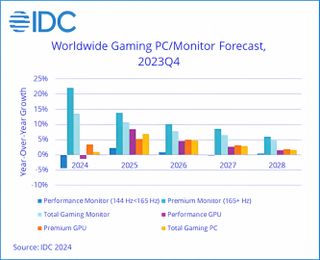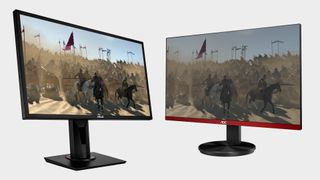Gaming PC and graphics card shipments will grow into 2025 'due to economic improvement as well as new GPUs'
IDC's latest Worldwide Quarterly Gaming Tracker report makes positive reading for the gaming market.

It's been no secret that shipments of gaming PCs and GPUs have been on a downward slide these past few years. On the other hand, high refresh rate gaming monitors have bucked that trend and sold like hot cakes on a frosty morning. However, market analysts International Data Corporation (IDC) are forecasting some significant changes once this year is over, with the growth in performance GPU shipments outstripping mainstream chips and gaming PCs.
The report from IDC paints a somewhat underwhelming picture for 2024, with shipments of normal gaming monitors falling roughly 4% compared to last year and total gaming PC shipments only increasing by a few percent. Premium gaming monitors (i.e. those with fresh rates greater than 165 Hz) are expected to improve by more than 20%, so at least that's nice.
But forget this year and just look at the forecasts for 2025 and further. The year-on-year shipment growth for gaming PCs is expected to be positive for the next four years, and while the actual figures aren't spectacular (around 6% in 2025, down to 2% by 2028), it's better news for the industry than in recent times.
The real stand out is for shipments of performance GPUs, with an 8% growth compared to 5% for premium GPUs. We're expecting Nvidia to announce the graphics version of its Blackwell AI GPUs around September this year, with the first cards potentially hitting shelves before the end of the year. Then, as the calendar rolls over into 2025, we should start to see the more mainstream cards in the series appearing.
We're also expecting the next generation of GPUs from AMD and Intel, RDNA 4 and Battlemage, later this year so by the end of 2024, there will potentially be a glut of new graphics cards to snap up.

IDC is clearly expecting them all to be very popular, especially those towards the middle of the performance spectrum. For its part, IDC classifies the 'Performance GPU' as an entry level discrete card, such as the Nvidia RTX xx50/60 level GPUs. The 'Premium GPU' tier then covers cards of a level with the Nvidia RTX xx70 series and up.
You can see this in the forecast as the year moves 2025 into 2026 and onwards. The initial interest in the performance segment tampers down, while the premium range holds fast for two years, but all of them start to dwindle as consumers begin to wait for the next round of new GPUs.
The biggest gaming news, reviews and hardware deals
Keep up to date with the most important stories and the best deals, as picked by the PC Gamer team.
The concern, however, is that all the graphics card makers launch with their flagship models first, and what IDC considers as performance GPUs don't launch until a lot further into a new generation's life cycle. If Blackwell, or whatever Nvidia calls it's RTX 50-series architecture, doesn't drop until the end of this year or early next, we're unlikely to see affordable cards until mid-2025.

Best gaming monitor: Pixel-perfect panels for your PC.
Best high refresh rate monitor: Screaming quick.
Best 4K monitor for gaming: When only high-res will do.
Best 4K TV for gaming: Big-screen 4K gaming.
But maybe we're taking too much of a Western view on this. IDC believes the rebound isn't just about a new generation of cards, but also an improving global economic system, particularly in China and the emerging markets.
"The rebound in 2025 is due to economic improvement as well as new GPUs." Jitesh Ubrani, research manager at IDC tells me. "China also plays a big role here as they are a large consumer but their economy has been significantly slower than the rest of the world and we expect improvements by 2025. Other emerging markets also play a similar role in the rebound."
Gaming PC, component, and peripheral vendors will undoubtedly hope that IDC's forecast is accurate. I suspect all the consumer will really care about, though, is whether the cost of PC gaming will be any more affordable in the years ahead.

Nick, gaming, and computers all first met in 1981, with the love affair starting on a Sinclair ZX81 in kit form and a book on ZX Basic. He ended up becoming a physics and IT teacher, but by the late 1990s decided it was time to cut his teeth writing for a long defunct UK tech site. He went on to do the same at Madonion, helping to write the help files for 3DMark and PCMark. After a short stint working at Beyond3D.com, Nick joined Futuremark (MadOnion rebranded) full-time, as editor-in-chief for its gaming and hardware section, YouGamers. After the site shutdown, he became an engineering and computing lecturer for many years, but missed the writing bug. Cue four years at TechSpot.com and over 100 long articles on anything and everything. He freely admits to being far too obsessed with GPUs and open world grindy RPGs, but who isn't these days?
Most Popular





